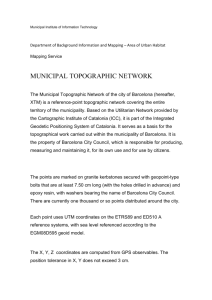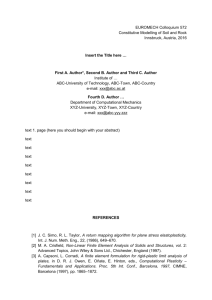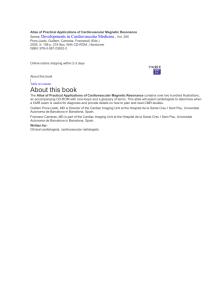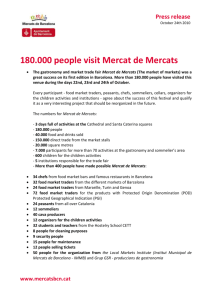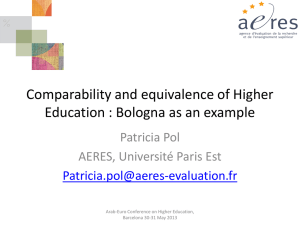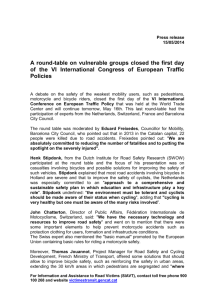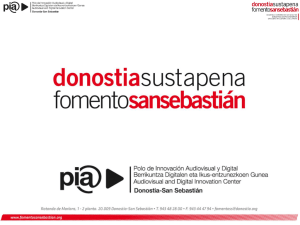Archaic sounds, modern ears
advertisement
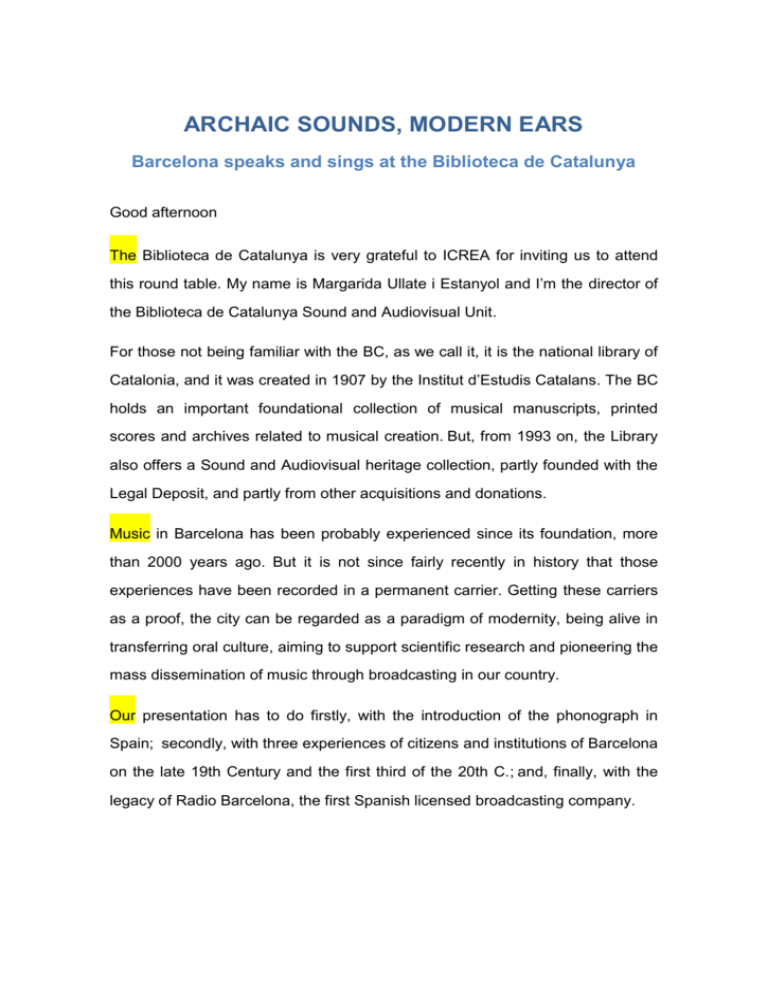
ARCHAIC SOUNDS, MODERN EARS Barcelona speaks and sings at the Biblioteca de Catalunya Good afternoon The Biblioteca de Catalunya is very grateful to ICREA for inviting us to attend this round table. My name is Margarida Ullate i Estanyol and I’m the director of the Biblioteca de Catalunya Sound and Audiovisual Unit. For those not being familiar with the BC, as we call it, it is the national library of Catalonia, and it was created in 1907 by the Institut d’Estudis Catalans. The BC holds an important foundational collection of musical manuscripts, printed scores and archives related to musical creation. But, from 1993 on, the Library also offers a Sound and Audiovisual heritage collection, partly founded with the Legal Deposit, and partly from other acquisitions and donations. Music in Barcelona has been probably experienced since its foundation, more than 2000 years ago. But it is not since fairly recently in history that those experiences have been recorded in a permanent carrier. Getting these carriers as a proof, the city can be regarded as a paradigm of modernity, being alive in transferring oral culture, aiming to support scientific research and pioneering the mass dissemination of music through broadcasting in our country. Our presentation has to do firstly, with the introduction of the phonograph in Spain; secondly, with three experiences of citizens and institutions of Barcelona on the late 19th Century and the first third of the 20th C.; and, finally, with the legacy of Radio Barcelona, the first Spanish licensed broadcasting company. To begin with, we’d drive your attention to a graphic document published by the Barcelona weekly La Academia in October 1878: it shows the presentation of the phonograph in Barcelona. This event took place at the Ateneu Lliure -a split from the Ateneu Barcelonès- on September 12th the same year, just seven months after the phonograph patent was registered by Edison in New Jersey. The existence of this plate was presented to us by professor Xavier Vall while the Library was preparing the exhibition Uns incunables del sonor. For many years, this event was wrongly located at the Ateneu Barcelonès in some bibliographic sources, so research was wrongly drived. Back to our picture, the name that appears on the right side of the plate corresponds to the optrician and owner of the phonograph used in the event, Francesc Dalmau. Authorities attending the event recorded some words, and invited artists performed short musical pieces facing the device. Among them, female singers Wehrle and Rovira, who would become familiar names in marketted cylinders and disc recordings in Barcelona the years to come. Unfortunately, all recordings made that day have not been preserved due to the ephemeral nature of the carrier, a thin sheet of tinfoil. But we can imagine how they would have sounded like if we listen to other documents of that time. Thanks to the innovations presented at the Barcelona’s and mainly Paris’ Universal Exhibitions of 1888 and 1889, some shops selling phonographs and other sound reproducton devices were set up in Barcelona at a small scale. The owner of one of these shops located in Barcelona’s Ramblas was the optrician and musician Josep Corrons Gutiérrez (1872-1918). The descendants of the Corrons family sold to the BC seven wax cylinders that had been recorded by some members of the family between 1898 and 1905. The recorded sounds include the voice of a baby child who is learning her first words, a conversation between father and son, an excerpt of the zarzuela "El joven Telémaco", a waltz performed on the piano and two popular fairly tales. Those are, together with the poet Jacint Verdaguer voice recorded on a wax cylinder, the oldest Catalan spoken recordings surviving. The tale El conte de la cabreta was transcribed on occasion of the World Day of Audiovisual Heritage, but no one has taken any interest on this collection so far. [If we don’t run out of time, we’ll listen to a snippet of a couple of them]. Another sound experience related to Barcelona is linked to Ruperto Regordosa Planas. Regordosa was a textile upper middle-class business man that in 1898 acquired an Edison Standard Phonograph Suitcase with all the accessories allowing him to record and play wax cylinders. He is quoted in the local press attending social and professional events, some of which showed his commitment to the Catalanism of his time. Regordosa was the only person in the world managing Isaac Albéniz to improvise some music on the piano to be captured and fixed. But our textile man also devoted himself to recording local and foreign musical and artistic personalities, probably while touring Barcelona. Among the unreleased recordings made between 1898 and 1918, the collection names pianists, actors, opera singers, choirs, virtuoso soloists, Spanish and Catalan folk music, and particularly 14 flamenco music cylindres which could be among the oldest non-commercial musical sound recordings preserved in Spain. Only the piano recordings have been transcribed, researched, remastered, and reissued. But the remains are still unresearched. Let’s now turn to a sponsorship for music research which was managed from a cooperation between two private institutions in Barcelona. On one hand, Rafael Patxot i Jubert (1872-1964) and, on the other, the Orfeó Català. Among many other initiatives that he promoted, Patxot sponsored the work of the Obra del Cançoner Popular de Catalunya (Popular Songbook of Catalonia). Its activity began in 1922 and was extended until 1936. The so-called missions or raids throughout the Catalan speaking countries involved leading experts of the time: from musicologist Mn. Higini Anglès and composer Baltasar Samper to philologist Pere Bohigas. Although the phonograph was becoming obsolete, in those years there were no "portable" devices for field recordings. So the phonograph was carried by men up to the mountains and overseas to Mallorca. Wax cylinders in this project were of a relative importance in the compilation of songs, for music was also written down on paper. The difficulties for transporting, manipulating, repairing, shaving cylinders or trying to found blank ones, and convincing peasants to have their voice "stealed," ended up in a sad oblivion of the recordings and its carriers. Some of the cylinders remained in Barcelona, in the Palau de la Música Catalana premises where they still are, but in an extremelly poor condition. The BC received a donation of 9 cylinders by Joan Codina, who found them by chance. His story was presented at IASA Conference and also explained in BC’s Blog. Four of the cylinders could be digitized and are now waiting for researchers to uncover their secrets. A selection of the cylinders of these three collections can be listened to at the Digital Memory of Catalonia. Moving on to the next experience, wax cylinders matched in time with another much more popular carrier widely used in Barcelona at the time: the piano roll1. In recent years, the BC has received the invaluable contribution of researchers to make us better understand the importance of this mechanical carrier. Piano rolls allowed live music to enter homes through different kind of player pianos and reproducing pianos. But they also could be heard in special auditoriums build for this specific purpose, and Barcelona had, at least, one named after the Hupfeld/Aeolian company. Thanks to several piano rolls collections acquired by the Library, and particularly those belonging to collector Daniel Blanxart, we discovered artist’s piano rolls. On one hand, researcher Dr. Lourdes Rebollo has prooved evidence of singular performances such as those made for the Hupfeld company by the Barcelona-born and celebrity pianist Alexandre Vilalta. On the other hand, Dr. Jordi Roqué has shared with us his experience in digitizing the paper of piano rolls to recover its sound. And, in addition, the BC is bringing these piano rolls sounds live on Tuesdays and Thursdays 9 a.m. Sound is also recorded live with preservation purposes and stored in a digital repository. Coming to an end, we should emphasize the importance of the advent of radio broadcasting. Luckily for the working class, the expensive activities of concertgoing or listening to recordings were not the unique ways of experiencing music. In 1924, the first licensed radio broadcasting company in Spain took its name from this city: Radio Barcelona. Despite being still active today, in 1994 it was decided to make its historical archive of magnetic tapes and recordings available to the general public, so it was offered to the Catalan Government. The final destination of the Archimag - or magnetic tapes programmes shots- and the Discoteca of shellac and vinyl records was the BC. Subsequently, this archive has been complemented by the private collection of former Radio Barcelona Head of Broadcastings Jordi Janer (19192009). The collectin added some interesting instantaneous pressing discs of the thirties to fifties recorded also by other broadcasting houses. But it is the vast amount of over 80,000 discs which crossed the air from Barcelona between the twenties and the ninetees of last century that can help us track the history of the music tastes of, at least, three generations in our country. In conclusion, the historical impact of music in the city has also probably reversed the question, putting Barcelona and its people in the role of leading music to become a central part of its life and aims. From the BC we expect to help present and future contributions to enhance this impact. Thank you.
